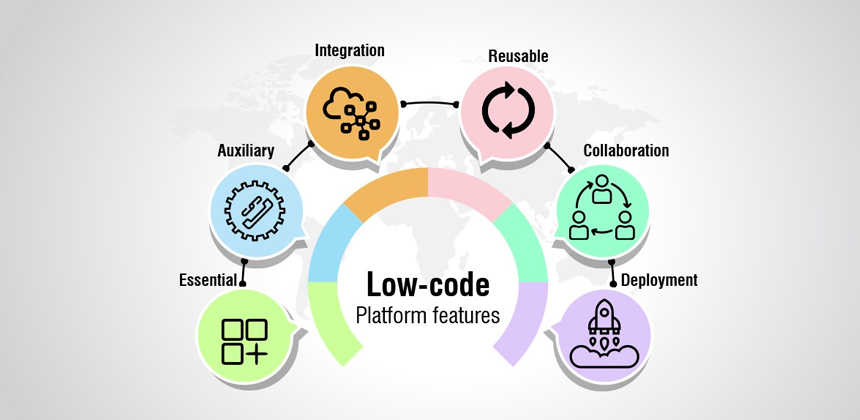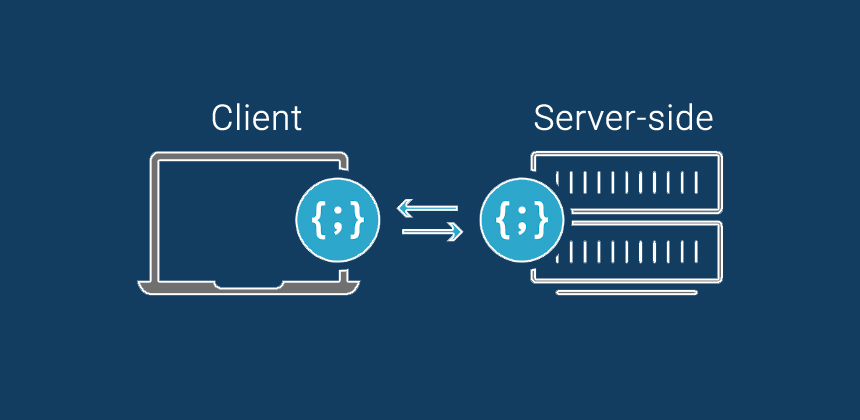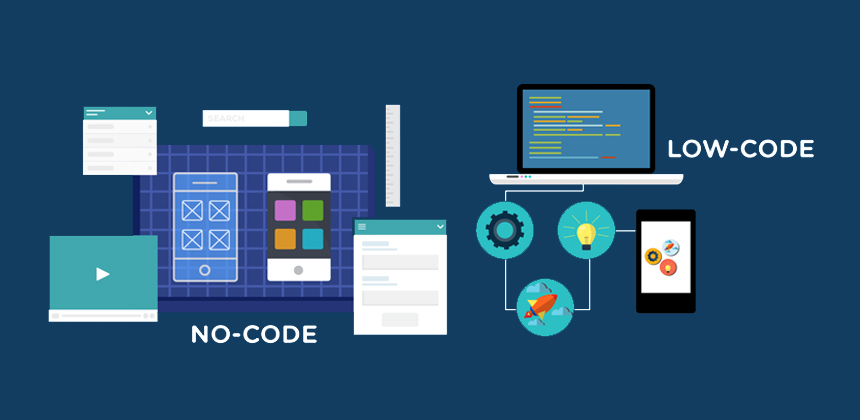Businesses across all business verticals are attempting to accelerate their digital transformation initiatives and investigate solutions that might assist them. Platforms that need little or no coding are at the top of their list. They are in the limelight for various reasons, including a scarcity of competent software engineers and a need to accelerate the turnaround time for digital transformation initiatives to address business challenges fast.
Allowing months of development and high prices is not feasible in the current environment. Businesses are suffering and need a means of survival. This is where Low-Code and No-Code platforms step in to save the day. However, a few misunderstandings surrounding low-code no-code platforms prevent enterprises from reaching the last step. These are the misconceptions we will dispel in our post, presenting you with the facts and assisting you in comprehending why these technologies are game-changers today.
Low-code architecture has been a buzzword for app developers and technical teams in recent years. Although low-code platforms allow the rapid development of (even complex) apps, numerous myths need to be debunked.
We have put together few myths regarding low-code no-code development that really need to be brought to the notice of our esteemed readers –
Myth #1: Low-Code Platforms Are Browser-Based Editors That Have a ‘What You See Is What You Get’ Experience:

Sometimes, low-code platforms are not browser-based. Other than that, they choose to operate natively on the local computer. Additionally, it should be noted that browser-based low-code systems have a small feature set. Whereas locally operated, low-code systems have links to source code and a more productive production environment.
Myth #2: Low-Code Development Is Suitable for Only the Most Basic Applications:

Low-code solutions move away from conventional tech creation for large and small businesses regarding developing laptops, tablets, and online apps.
As a result, low-code is an appealing alternate solution for developing large-scale business apps supporting digital transformation initiatives. Scalable low-code architectures can support thousands of consumers and millions of data sets. The majority of low-code systems are enterprise-wide or scaled for several divisions. Low-code frameworks allow businesses to rapidly design stable, unique, and intricate apps at a fraction of the cost of traditional development tools. Numerous companies that have benefited from low-code development growth are expanding their accelerated development teams to meet rising demand and continue providing mission-critical business apps. Low-code is about maximizing benefit, not minimizing suffering.
Myth #3: Low-Code Platforms Induce Lock-In:
While specific low-code systems may have vendor lock-in, essentially making consumers slaves of a company’s services or software, others provide complete vendor freedom. Since these low-code systems produce software using only open source technologies, there is little need for lock-in. Additionally, they can be modified and expanded using any Java IDE. The modus operandi of these low-code sites is liberty since they provide it to their customers. They are fully compliant with any extensive database, any Java app server, and any cloud, on-premises, or OS that supports Java. If you can see, low-code scores highly for freedom, adaptability, and usability.
Myth #4: Low-Code Development Does Not Need Custom Coding:

Software developers may use code to build reusable code extensions. Engineers can develop, bundle, and deliver new functionalities such as connectors to external services such as deep learning and artificial intelligence by using client- and server-side APIs and enabling developers to stretch the limits of the core architecture to make better applications much faster would be possible by the use of code to expand the framework’s native functionality.
Myth #5: Low-Code Platforms Reduce the Need for Development Teams:
Low-code systems reflect logic using graphic modeling techniques and convert the underlying code into a visual format that developers and enterprise users may comprehend

Since developing enterprise-ready apps at a rapid pace and size needs a continuum of developers, a cross-functional team that can engage in the production phase creates the optimal environment for integrating software development into a company. Excellent strategic concepts can be transformed into implementations even more quickly, and software teams can relax their concerns over technical debt and resource limitations. Although some low-code platforms allow business users to create simple apps, the apps required to facilitate digital transformation are anything but simple. These are high-profile, industry-wide, and enterprise-grade software that must be quickly developed and implemented into enterprise information systems — all by experienced developers. Citizen developers and company consumers will get underway with Low-Code applications, while professional developers can push them to the next level.
Myth #6: Low-Code No-Code platforms are only a Trend:
The platforms may be trending, but they are not simply another fad/trend. Low-code development was announced back in 2014, although the principle has been present since the 80s. It is only recently that no-code and low-code platforms have risen to stardom. The most significant difference between the old tools of the 80s and low-code no-code platforms today is, of course, the simplicity and capability. So, these are not merely trends that will vanish away. They are here to stay!
According to Business Wire, the future is low-code or no-code, with a predicted growth rate of 44.4 percent by 2022 to $ 27.23 billion (up from $ 4.32 billion in 2017). Ref link to https://www.businesswire.com/news/home/20180116006370/en/27.2-Billion-Global-Low-Code-Development-Platform-Market-2017-2022-by-Component-Deployment-Mode-Organization-Size-and-Vertical—ResearchAndMarkets.com
Myth #7: Low-Code Platforms gives Rise to Lock-in Effects:

Their approach is not unique when it comes to low-code and no-code platforms. All cloud-based subscription management software operates in the same manner. They operate on a pay-as-you-go basis, with clients paying monthly or annually. Customers retain access to the program as long as they continue to pay for it.
Customers must, however, ensure that the platform provider permits them to export their whole data at the time of service termination.
Myth #8: Platforms with little or no code are insecure:
This is platform-dependent. The correct platform will never skimp on security. They will guarantee that all security and privacy standards are met.
Security is a major worry when it comes to cloud computing. However, all reputable low-code no-code vendors recognize the need for security, privacy, and compliance. These players guarantee that the appropriate controls are in place across their operations, including application design, development, delivery, hosting, and maintenance, to guarantee that security and privacy are never compromised. And to reassure customers, platform providers have their security procedures verified to the industry’s most acceptable security standards. ISO 27001 and SSAE18 SOC 2 are two of these standards.
Myth #9: Low-Code No-Code Platforms hamper collaboration:

This kind of development requires a greater degree of cooperation than conventional development. If you’ve been following along with the myths and facts, you’ll already be aware that collaboration is a critical component of low-code and no-code platforms. Historically, developers have worked alone to produce thousands of lines of code. By contrast, business users collaborate to create the final product with no-code while being supervised by the central IT team. Every one of them has a say! Indeed, we had witnessed several instances when the whole business helped.
Myth #10: Low-Code No-Code platforms are not flexible:
Low-code and no-code platforms were designed with flexibility and simplicity of use in mind! Users may transform their concepts into apps in a matter of minutes or hours. As with ready-to-use software, users are not restricted in terms of capability. They may change or increase the functionality at any moment to suit their needs.
This is one of those ridiculous illusions regarding low-code no-code platforms since the whole point of these platforms is to provide business developers the freedom to address their particular difficulties and create bespoke applications according to their specifications. Additionally, they are changing swiftly because they are necessary, and flexibility is being pushed to new heights!
Myth #11: Low-code No-Code platforms are very restricted and cannot scale:

Although early low-code and no-code platforms had limitations, the newest cloud-based advanced low-code and no-code platforms provide limitless scalability and performance.
Numerous firms began with a single process and subsequently expanded across the whole department using low-code no-code platforms. Later, this was broadened to include numerous departments. The majority of firms currently operate at least two departments entirely on low-code no-code platforms.
These systems enable businesses to automate both core and support tasks. Businesses of all sizes turn to them to accelerate their digital transformation journeys.
Myth #12: Low-Code No-Code platforms are suitable only for lightweight apps:
Advanced low-code and no-code platforms may develop applications ranging from basic to very sophisticated. Several examples include an insurance claim processing system and a complete human resource management system built on the Quixey platform. On the other hand, traditional no-code platforms impose constraints on the sophistication of the applications that may be built utilizing the platform.
This is one of the fallacies regarding low-code no-code platforms that contribute to their lack of popularity. Numerous firms concur that since low-code platforms enable the creation of custom code, they may be utilized to create enterprise-grade applications. However, they inquire, what about no-code applications? The tide has turned, and with specific, powerful no-code platforms, you can now work with a wide variety of functions like reporting, complicated workflows and business rules, alerts and triggers, and automated forms, among others, to create complicated enterprise-grade apps.
Myth #13: Low-Code No-Code platforms make coding obsolete:
Low-code and no-code platforms have one feature: they include visual tools and pieces that enable users to construct programs intuitively using drag-and-drop and visual interfaces. This significantly decreases the time and expense of application development.
When considering no-code, you do not want to code as the term implies. Thus, this misconception does not apply to no-code development.
When it comes to low-code, though, some amount of coding is essential. This is because business process modeling, data integration, and comparable functionality are intricate and require writing lines of code. It’s worth mentioning that some of the most powerful no-code platforms available today enable executing some of these complicated operations without requiring any coding.
Myth #14: anyone can use Low-Code No-Code platforms to build apps:

While low-code and no-code application development are far easier and quicker than the conventional methodology, they still demand users to have a solid functional understanding of the business needs and skill with the low-code no-code tool’s capabilities.
While no-code platforms are more suited to business users and citizen developers due to the lack of coding required to utilize them, low-code platforms are better suited to power users (business users with technical capabilities) and professional developers. To eliminate the possibility of shadow IT, however, the installation must be overseen by a central IT staff.
Myth #15: With Low-Code No-Code Platforms, custom development is not possible:
Without the need for expensive tools or considerable coding, advanced low-code and no-code platforms provide a reasonable amount of customization.
Given that the goal of low-code and no-code development is to do as much as possible without using code (or as little code as possible), the lack of customization is one of the most prevalent misunderstandings regarding low-code no-code platforms today. A low-code platform’s functionality may be expanded as needed by software developers. Regarding no-code platforms, the sophisticated ones on the market today provide a great deal of flexibility to address this. Thus, although this was a worry with conventional no-code systems, today’s sophisticated solutions are very capable of meeting the challenge.
Myth #16: Use of Low-Code No-Code platforms lead to the creation of “Shadow IT”:

When implemented effectively, low-code no-code platforms empower power users, citizen developers, and business users to solve their unique problems and construct applications under the supervision of the central IT team. The central IT team’s governance precludes the potential of shadow IT.
Shadow IT is a term that refers to the unmanaged and unregulated creation and usage of applications. The danger is that since low-code no-code development is so simple, anybody may start developing and utilizing applications, resulting in application silos inside the business and chaos. As a result, oversight by the central IT staff is critical. Without the possibility of Shadow IT, the IT backlog may be resolved rapidly with effective oversight from the primary IT team.
Myth #17: Low-Code No-Code Platforms address only the “Build” phase of the application development:
Low-code no-code platforms correctly configured handle the whole application development lifecycle, from concept through deployment and maintenance.
We can see why this is one of the most widely held misconceptions regarding low-code no-code platforms. That is the title! Their applications, on the other hand, are pretty sophisticated. They are not just concerned with the construction phase but with everything else as well. This comprises the design, implementation, testing, and deployment of the application and its maintenance.
Additionally, specific systems provide agile project management, user feedback loops, and social collaboration. All of these aspects contribute to the application’s seamlessness throughout its lifecycle.
Myth #18: Low-Code No-Code Platforms only work for small departmental applications:
Low-code and no-code applications are presently employed in enterprises worldwide to develop sophisticated corporate systems. While classic no-code platforms are well-suited for developing modest departmental apps, sophisticated no-code platforms such as Quixy enable business users to create sophisticated enterprise-grade apps. Low-code platforms may create even more complex applications, but this requires technical expertise.
Many businesses have been slow to hop on the low-code, no-code bandwagon because it seems simplistic — as if only easy solutions are feasible. Once they had a better understanding of it, they recognized that these platforms could do far more than minor tasks. After beginning modestly, the majority of apps are now scaled and enlarged. It may begin with the onboarding process for a new employee, but it often spreads to the whole department and subsequently to the others.
Myth #19: Low-Code No-Code platforms are only for citizen developers:

Many corporate owners are suspicious about low-code and no-code platforms because they seem to be designed only for citizen developers. However, these platforms enable cross-functional teams to collaborate on application development. These platforms foster collaboration among team members to develop solutions to address their particular difficulties.
While no-code platforms are more suited to business users and citizen developers due to their lack of coding requirements, low-code platforms are more suited to power users (business users with technical capabilities) and professional developers.
Myth #20: No customization is possible using low-code tools:
Another significant worry (and misconception) associated with low-code is customization. Many argue that platforms do not allow for custom code or customization of created apps. While I cannot vouch for all low-code tools (since I have not tried them all), new tools will not restrict your customization. Again, I cannot guarantee that every tool allows for complete customization. However, this is something you should examine before purchasing any tool.
Myth #21: Low-code entails the absence of programming:

Low-code platforms provide visual development tools that enable business analysts and developers to collaborate and swiftly create solutions that match business requirements. Drag-and-drop tools and templates cover typical use cases, speeding development and allowing the technical team to concentrate on the customization that differentiates their unique applications.
This no-coding interface is so alluring — and so powerful — that some believe this is the extent of a low-code platform. However, this is just the beginning. Low-code platforms enable you to expand an application’s functionality beyond its visual design capabilities, allowing you to expand any aspect of an application you develop with them. These will allow you to easily combine pages created using the UI builder with custom code pages.
Myth #22: Low-code implies the absence of collaboration and reusability:
This myth began due to a low-code platform’s ability to enable various technical teams across the enterprise to begin developing their solutions independently. This enables dispersed teams to become productive more quickly but raises questions about efficiency and collaboration. At some point, each team will need to connect to existing corporate systems, and in the absence of collaboration or reuse, each team will have to develop its extension to accomplish this.
On the other hand, low-code platforms may help increase efficiency via reusable components and cooperation. For instance, a developer can also write down a connector in order to integrate an internal CRM solution and easily share it with all other teams via a version control system using a completely modular low-code architecture.
After busting all the myths, now it’s time to reveal one truth about the Low Code Development
One Truth: Platforms for low-code development are proprietary:
Today’s most advanced low-code platforms are proprietary. While many believe that proprietary platforms provide developers with additional functionality, this is also a bit of a myth! Many developers prefer to work with open standards whenever possible and avoid proprietary frameworks. Open source code frees developers from the constraints imposed by a single company’s upgrade and enhancement schedule while also allowing them to leverage the experience and creativity of developers worldwide.
Conclusion
We hope you’ve realized that most falsehoods concerning low-code no-code platforms include not a shred of reality. While a few may have sprung from particular truths, current platforms have resolved those issues as well. This is why we can all state categorically that these platforms are not fiction. They are a fact of life.
If you have doubts about the low code development or inquisitive to know how low code development by our developers can help you, shoot us an email at info@zestminds.com, we will be more than happy to assist you.
